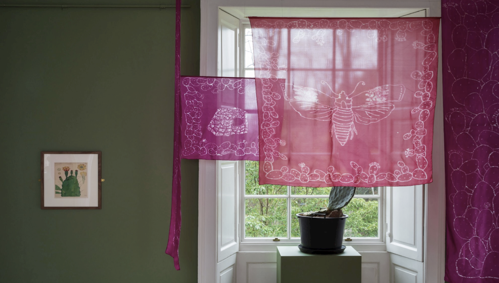Consequences of bygone deeds reverberating down the centuries are explored in Shipping Roots, an exquisite, insightful and globally relevant new exhibition by Keg de Souza at Inverleith House from Friday, March 24 to Sunday, August 27. Occupying two floors of the gallery sitting at the heart of the Royal Botanic Garden Edinburgh (RBGE), it is a compelling invitation to consider how the introduction of plant material impacts landscapes and lives in a multitude of ways.
Flowing through the rooms of the gallery are three strands of seldom explored narratives: recalling the spread of the distinctive Australian eucalyptus, often prized by gardeners but contributing to alarming destruction in habitats around the world; the American prickly pear (Opuntia), a cactus shipped to India and Australia as habitat for the lucrative cochineal insect; and the “hitchhiker” seeds and burrs that made their way from Australia to British woollen mills.
The common theme is empire: looking back to times when British expansionism was based on exploitation and its mass fleet of merchant ships transported people and goods along the ocean trading routes of the world. Shipping Roots is the artist’s first major UK exhibition and draws on her own life experiences to address the impact of moving plants and people between continents. As a person of Goan heritage, whose ancestral lands in India were colonised, she lives as a “settler” on unceded Gadigal land known the world over as Sydney, its colonial name and significantly the landing point for the “First Fleet” of 11 British ships carrying around 1,500 people - including 700 convicts - to start a new penal colony there in 1788.
But, far from focussing on the past, this is an exhibition exploring current and future dilemmas. The links between Australia, India and the UK demonstrate how the entanglement of plants and people are inextricably tied to the understanding of place and a notion of belonging. Long gone misdemeanours are also playing their part in the biodiversity crisis and climate emergency of the 21st century as non-native species take their toll on habitats not able to cope with their presence.
The artist said the intentions behind Shipping Roots was to produce an exhibition to make people reflect on the past in order to think for the future. The destructive impact still witnessed today, invoked by the British Empire and accelerated by European colonial expansion, continues to massively alter ecosystems. We now live in a world where the legacy of colonialism on land and landscape through this movement of plants has left lasting impacts, many of which have propelled us towards climate crisis.
She explained: “As artist in residence, over an extended period of time in Edinburgh during 2022, I had invaluable interactions with RBGE scientists and conservation horticulturists, as well as extensive access to its living and preserved plant collections, alongside its library and archives. Given the time to undertake my research and learn of the experiences of individuals in an organisation dedicated to exploring the world of plants and conserving biodiversity helped me understand the RBGE Archives in the present day and add dimension to this exhibition.”
First of the three strands, Blue Haze echoes the journey of the Eucalyptus away from its culturally significant Aboriginal land to destinations around the globe, including the artist’s Indian ancestral land where it is the most common tree in timber plantations. It has been utilised for a raft of products from road cobbles to telegraph poles. Now, covering a land mass area over 22 million hectares worldwide, in many countries these prolific trees are contributing to environmental devastation by lowering water tables and increasing fire risk.

In Green Hell the spotlight is on the lasting impact of failed attempts to establish cochineal dye industries in India and Australia by introducing both the insect from which a bright red colour is extracted and the invasive prickly pear cactus on which it feeds.

Closer to home, Fleece Fugitives tells how the movement and spread of plants is not always intentional. When the high-quality fleeces of Australian sheep breeds were transported across the seas some were carrying hidden hitchhikers in the form of seeds and burrs. The British wool industry inadvertently allowed these tiny stowaways to escape through wool waste or “shoddy” and in the effluent from the mills. Once released, seeds propagated and diversified the landscape along riverbanks.
Applying a raft of vibrant and cool colours, an array of textures, natural dyes and materials and perfumes, Shipping Roots stimulates the imaginations and senses of both adults and children. Further reason to linger in Inverleith House comes from items from the Herbarium and Archives, with the addition of rooms offering floor jigsaws, wooden building blocks, reading chairs and maps.
Shipping Roots, which is part of the Edinburgh Art Festival from July 27 to August 27, is supported by the Outset Transformative Grant; the Australian Government and the British Council as part of the UK/Australia Season; the Australian Government through the Australia Council, its arts funding and advisory body; the NSW Government through Create NSW; and a City of Parramatta Council Community Grant.


